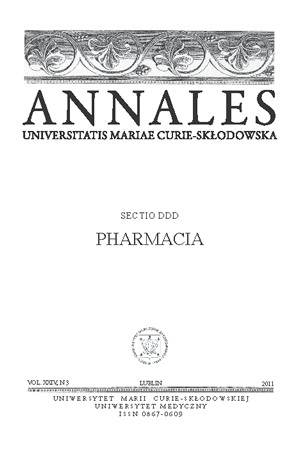Natural inhibitors of metalloproteinases from various families of MA clan from wood degrading fungi
DOI:
https://doi.org/10.12923/Keywords:
wood rotting fungi, metalloproteinase inhibitors, matrix metalloproteinases, bacterial metalloproteinases, bioactive substancesAbstract
In higher organisms changes in level of proteases and/or their inhibitors are connected not only with organism homeostasis, but also with diseases and illnesses. One of protease clan – MA, contain metalloproteases connected with pathological processes like arthritis, tumor diseases and multiple sclerosis (family of matrix metalloproteinase – MMPs from vertebrates) and bacterial infection processes (family of thermolysin and family of bacterial collagenase). Fungi are very interesting and promising new resources of proteolytic enzymes and their natural inhibitors. All catalytic classes of enzymes and some families of natural protease inhibitors were found in them. But the least known are fungal inhibitors of metalloproteinases From some species of wood rotting fungi, obtained both from fruit bodies from nature and from laboratory, mycelial cultures, new inhibitors of few families from MA clan of metalloproteinases were extracted. Fractions active against metalloproteinases were extracted with few polar and nonpolar solvents. Inhibitory parameters against various families of metalloproteinases were characterized with chosen marker enzymes from concrete metalloproteinase family. Results obtained suggest that isolated substances are both organics (similar to hydrochinones and polyporenic acids from Piptoporus betulinus.), and peptides (low-molecular proteins or high-molecular oligopeptides). They have inhibitory activity both against MMPs and bacterial metalloproteinases. And they both are very promising bioactive substances (few extracts are really very active in comparison with available literature data).
References
1. Baker A.H., Edwards D.R., Murphy G.: Metalloproteinase inhibitors: biological actions and therapeutic opportunities. J. Cell Sci. 115, 3719, 2002.
2. Barrett A.J., Rawlings N.D., O’Brien E.A. The MEROPS database as a protease information system. J. Stuct. Biol., 134, 95, 2001.
3. Bode W., Huber R.: Natural protein proteinase inhibitors and their interaction with proteinases. Eur. J. Biochem. 204, 433, 1992.
4. Bode W., Huber R.: Structural basis of the endoproteinase-protein inhibitor interaction. Biochim. Biophys. Acta 1477, 241, 2000.
5. Sabotic J, Trcek T, Popovic T, et al.: Basidiomycetes harbour a hidden treasure of proteolytic diversity. J. Biotechnol., 128, 297, 2007.
6. Frederics W.M., Mook, O.R.F.: Metabolic mapping of proteinase activity with emphasis on in situ zymography of gelatinases: review and protocols. J. Histochem. 52, 711, 2004.
7. Grzywnowicz K. et al.: Natural inhibitors of metalloproteinases from fungi and herbs – new bioactive extracts of pharmacological potential. Annales UMCS – Polonia sec. DDD. 23, 41, 2010.
8. Kawagishi H., Hamajima K., Inoue Y.: Novel hydroquinone as a matrix metallo-proteinase inhibitor from the mushroom Piptoporus betulinus. Biosci. Biotechnol. Biochem. 66, 2748, 2002.
9. Kim W.J. et al.: Keumsa linteusan suppresses invasion of cancer cells through the inhibition of cellular adhesion and MMP-9 expression. Animal Cells Systems 13, 113, 2009.
10. Lee T-M., Lin Y-H.: Trypsin inhibitor and trypsin-like protease activity in air- or submergence-grown rice (Oryza sativa L.) coleoptiles. Plant Sci. 106, 43, 1995.
11. Lombard C., Saulnier J., Wallach J.: Assays of matrix metalloproteinases (MMPs) activities: a review. Biochimie 87, 265, 2005..
12. Rawlings N.D., Tolle D.P., Barrett A.J.: Evolutionary families of peptidase inhibitors. Biochem. J. 378, 705, 2004.
13. Wandersman C. Secretion, processing and activation of bacterial extracellular proteases. Mol. Microbiol., 3, 1825, 1989.
14. Weng C.J. et al.: Inhibitory effects of Ganoderma lucidum on tumorigenesis and metastasis of human hepatoma cells in cells and animal models. J. Food Agricult. Food Chem. 57, 5049, 2009.
Downloads
Published
Issue
Section
License
Copyright (c) 2011 Authors

This work is licensed under a Creative Commons Attribution-NonCommercial-NoDerivatives 3.0 Unported License.


